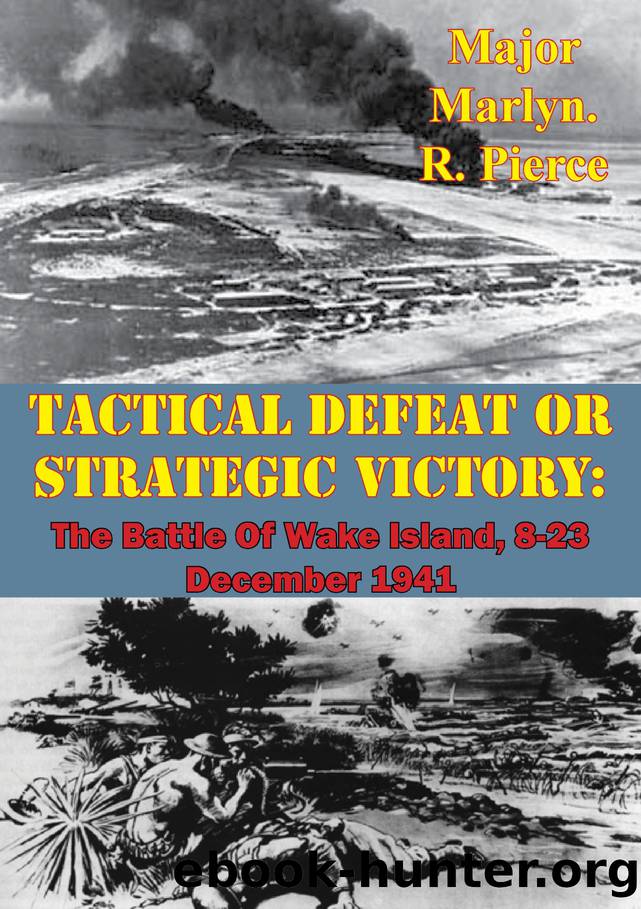Tactical Defeat Or Strategic Victory: The Battle Of Wake Island, 8-23 December 1941 by Pierce Major Marlyn. R.;

Author:Pierce, Major Marlyn. R.;
Language: eng
Format: epub
Publisher: Verdun Press
Published: 2015-10-14T00:00:00+00:00
CHAPTER FIVEâCONCLUSION
Could Wake Island have been relieved? The answer appears to be driven by time frame and point of view. By defeating the Japanese assault on 11 December, the defenders bought time for the Navy to mount a relief effort. By 23 December, when the Japanese mounted the second and successful assault, the situation had changed dramatically. To quote Commander Cunningham, âthe issue was in doubt.â What was missing was a sense of urgency and the will to see the operation through.
Even prior to 11 December Admiral Kimmel had begun planning to reinforce Wake Island. Operations in the waters off of Wake Island were, after all, part of his pre-war plan to use the island base as bait. But his pre-war plan was predicated on an intact fleet and sufficient intelligence to track the movements of the Japanese forces as they entered the trap. The Japanese attack on 7 December left the fleet badly crippled and in the aftermath the location of the Japanese Fleet was unknown.
Still Kimmel possessed the warriorâs spirit and wanted to get at the enemy. He organized the relief around his three aircraft carriers, the sole offensive capability he had remaining. However, one, Saratoga, was located in San Diego and would require several days sailing before she reached Pearl Harbor. This was the first of many delays that would jeopardize the relief of Wake Island.
Once Saratoga reached Pearl Harbor she would have to refuel and take on the Marine relief air squadron. More time lost but the defenders on Wake were doing their part and steadfastly holding on.
The defeat of 11 December was nearly as shocking to the Japanese as their attack on Pearl Harbor had been to the Americans.{150} They evaluated the situation and determined the seizure of Wake Island would need more preparation, not to mention a larger force. This would take time, time for American reinforcements to arrive.
Once again, the Japanese discounted American ability. The thought that the United States would or could reinforce Wake Island does not seem to have been considered. Or they may have correctly judged the mental state of the Pacific Fleet leadership following their surprise attack on Pearl Harbor.
Kimmelâs plan had the support of the Secretary of the Navy and the Chief of Naval Operations. However, it appears there was some doubt in Kimmelâs mind on the importance of relieving Wake Island. By placing Admiral Halsey, his most aggressive commander, in charge of protecting the approaches to Hawaii Kimmel signaled where his priority lay, the defense of the Hawaiian Islands. There is also the controversy of putting Admiral Fletcher, a career surface sailor, in charge of carrier task force. And political factors also weighed against Kimmel remaining in command of the Pacific Fleet until the mission was complete. A sense of urgency was being lost.
Admiral Pye as Kimmelâs successor was reluctant to risk what remained of the Fleet on what he considered a gamble. He understood his role was merely the interim caretaker of the Pacific Fleet until Admiral Nimitz could arrive.
Download
This site does not store any files on its server. We only index and link to content provided by other sites. Please contact the content providers to delete copyright contents if any and email us, we'll remove relevant links or contents immediately.
| Central Asia | Southeast Asia |
| China | Hong Kong |
| India | Japan |
| Korea | Pakistan |
| Philippines | Russia |
The Rape of Nanking by Iris Chang(3518)
The Sympathizer by Viet Thanh Nguyen(3487)
World without end by Ken Follett(3008)
Ants Among Elephants by Sujatha Gidla(2925)
Blood and Sand by Alex Von Tunzelmann(2610)
Japanese Design by Patricia J. Graham(2557)
City of Djinns: a year in Delhi by William Dalrymple(2137)
Inglorious Empire by Shashi Tharoor(2102)
Foreign Devils on the Silk Road: The Search for the Lost Treasures of Central Asia by Peter Hopkirk(2056)
In Order to Live: A North Korean Girl's Journey to Freedom by Yeonmi Park(2055)
Tokyo by Rob Goss(2018)
India's Ancient Past by R.S. Sharma(1988)
India's biggest cover-up by Dhar Anuj(1985)
The Great Game: On Secret Service in High Asia by Peter Hopkirk(1962)
Tokyo Geek's Guide: Manga, Anime, Gaming, Cosplay, Toys, Idols & More - The Ultimate Guide to Japan's Otaku Culture by Simone Gianni(1947)
Goodbye Madame Butterfly(1937)
The Queen of Nothing by Holly Black(1757)
Living Silence in Burma by Christina Fink(1731)
Batik by Rudolf Smend(1721)
